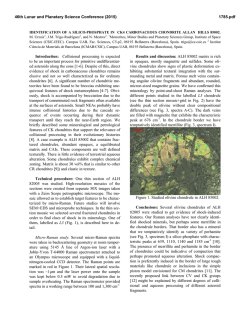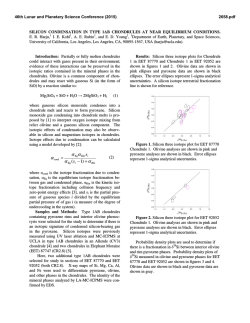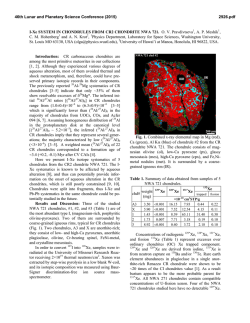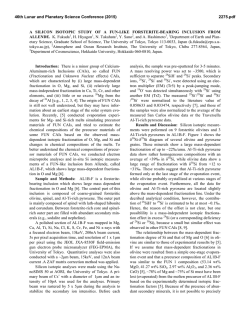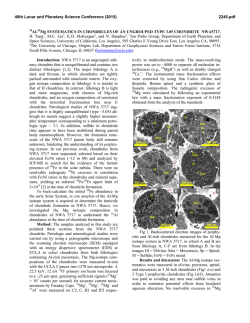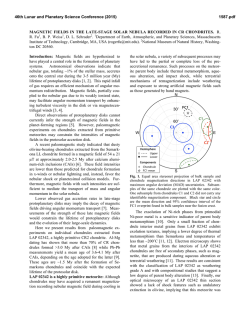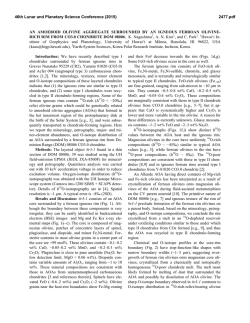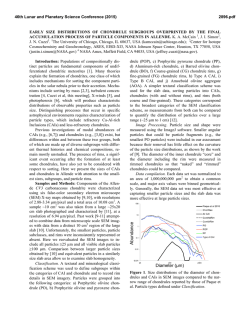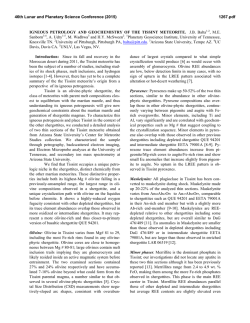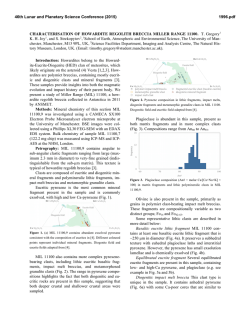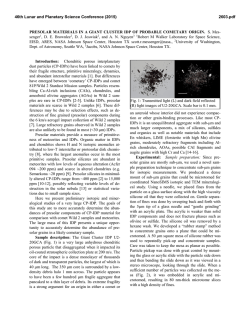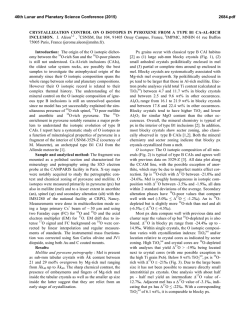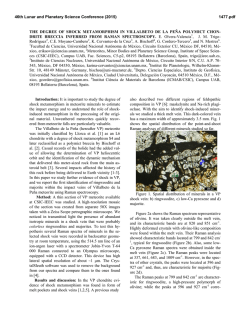
Oxygen Isotope Analyses by SHRIMP of Chondrules in Highly
46th Lunar and Planetary Science Conference (2015) 1674.pdf OXYGEN ISOTOPE ANALYSES BY SHRIMP OF CHONDRULES IN HIGHLY UNEQUILIBRATED LL3 CHONDRITES. J. C. Bridges1 and T. R. Ireland2, 1Space Research Centre, Dept. of Physics and Astronomy, University of Leicester, LE1 7RH, UK. [email protected] 2Research School of Earth Sciences, College of Physical and Mathematical Sciences, The Australian National University Canberra, Australia. [email protected]. Introduction: In order to accurately determine the effects of parent body fluid-rock interaction on Oisotope partitioning between different phases in OC chondrules, and to distinguish different O-isotope reservoirs within the OC parent bodies, we are determining the δ17O and δ18O values of minerals within chondrules of highly unequilibrated LL ordinary chondrites. It has previously been shown, using density separates and cristobalite-rich clasts, that there is a mineralogical control to positions along OC mixing lines between 16 O-rich and 16O-poor e.g. feldspar, silica polymorph, glass compositions [1,2] relative to bulk OCs [3]. The highly unequilibrated OCs show mineralogical signs of alteration including phyllosilicate and magnetite, together with corroded textures e.g. [4], and this waterrock interaction is likely to be associated with oxygen isotope exchange. Using high resolution SHRIMP analyses allows analyses of individual grains in LL chondrules to determine the controls on oxygen isotopic exchange associated with LL chondrites. Methods: Thin sections of Semarkona LL3.0 USNM 1805-18, Krymka LL3.2 M10109, and epoxy mounts of Chainpur 1915,86, LL3.4, were imaged and analysed with SEM-EDX. The oxygen isotope analyses were performed with the SHRIMP-SI stable isotope ion microprobe operating in multiple-collection mode. Samples were carbon coated prior to analysis. A primary Cs ion beam of ca. 5 nA was focused to ca. 20 x 25 µm to sputter the samples. A medium energy electron beam (ca. 2.7 keV) was used to neutralize charge build up from the Cs primary ion beam. Mass resolution was ca. 5500 (M/ΔM, 10% peak height) during the course of the analyses. The sample was rastered with the primary beam for one minute to remove the coating at the edge, and a static beam was left to sputter for a further minute. During this time, detector backgrounds were measured. Secondary ion tuning was performed automatically with optimisation of steering on the extraction plate, and steering of the electron beam. Secondary ion beam intensities were measured by Faraday cup current mode with 16O measured on a 1011Ω resistor and 17O- and 18O- measured on 1012 Ω resistors. The typical count rate of 16O- was 500 MHz. Data were collected in 3 sets of 10 scans, each comprising 10 two-second integrations. Oxygen analyses were nor- malized to pyroxene from the FC1 locality used for zircon standards [5]. Typical uncertainties in δ18O were ca. 0.2 ‰, δ17O 0.5 ‰ and Δ17O 0.2 ‰. The internal normalization of Δ17O removed the correlated variation of δ18O and δ17O due to mass dependent fractionation (which appears to be largely instrumentally induced). Results: Mineralogy of the Chondrules. We have studied chondrules with representative textures and mineral compositions in each of the 3 meteorites, with porphyritic, poikilitic and barred textures. Fig.1A. shows an example of a porphyritic pyroxene chondrule from Krymka with albitic glassy mesostasis that was subsequently analysed by SHRIMP (Fig. 2). Fig. 1B is an Al-rich chondrule S5 in Semarkona, with MgAl2O4 spinel, Al-rich pyroxene (19 wt% Al2O3) and forsterite. Figure 1. SEM images of A. Krymka chondrule K2 and B. Semarkona Al-rich chondrule S5. Lettering marks position of the analysis spots. M is albitic glassy mesostasis, en enstatite, px Al-rich pyroxene, ol forsterite olivine, sp Al-spinel. Scale bar in A is 500 µm, in B 200 µm. Oxygen Isotopes. The feldspathic mesostasis isotopic compositions in Semarkona, Krymka and Chainpur all consistently show heavy isotopic analyses (Fig. 46th Lunar and Planetary Science Conference (2015) 2). The Semarkona analyses are most 16O-poor, with up to δ18O 12.9, δ17O 10.6 ‰, Krymka mesostasis is up to δ18O 8.6, δ17O 8.2 ‰, and Chainpur δ18O 8.4, δ17O 7.6 ‰. Δ17O values range up to +3.6 ‰ for the Semarkona mesostasis and +3.9 ‰ for Krymka mesostasis. In contrast, the olivines and pyroxenes in the chondrules of all 3 meteorites show a closer range of values between δ18O -1.6 and 5.1 ‰, close to the TFL. An exception to this pattern of fractionation between 16O-poor feldspathic mesostasis and the ferromagnesian minerals, is the Semarkona Al-rich chondrule (S5). This shows (Fig. 2) overall relative 16Oenrichment, including a spinel grain with δ18O -12.1, δ17O -9.5 ‰, together with Al-rich pyroxene and olivine with 16O-rich compositions relative to the olivine and pyroxene in the other chondrules of the 3 meteorites. Figure 2. Oxygen Three Isotope Plot. ECL Equilibrated Chondrite Line, TFL Terrestrial Fractionation Line. Typical uncertainties in δ18O were ca. 0.2 ‰, δ17O 0.5 ‰ and Δ17O 0.2 ‰. Krymka K2 (Fig1) mesostasis is δ18O 8.6, δ17O 8.2 ‰. Typical uncertainties in δ18O are ca. 0.2 ‰, δ17O 0.5 ‰ and Δ17O 0.2 ‰. Also shown is an Adrar 003 LL3.2 feldspar-rich density separate [1] and cristobalite clast [2]. Discussion: The effects of parent body thermal metamorphism are clear in the differences between the 3 meteorites. Semarkona LL3.0 - the least equilibrated of the 3 - has preserved the earlier effects of low temperature parent water-rock reaction. This is manifested in the relatively large isotopic fractionations between the glassy feldspathic mesostasis and olivine, pyroxene. In contrast, Krymka LL3.2 and Chainpur LL3.4 which show greater degrees of thermal equilibration, have partially equilibrated oxygen isotopes and smaller frac- 1674.pdf tionations between the feldspathic mesostasis and olivine, pyroxene. This is consistent with the main period of anhydrous, thermal metamorphism occurring after aqueous alteration on the LL parent body. A high degree of isotopic equilibration can be attained rapidly for feldspar–H2O exchange e.g. less than 100 years for a 10 µm grain of albite at 400°C [6]. Silica polymorphs and feldspathic glass have similar exchange properties. In contrast, gas–solid equilibration times for forsterite and low Ca pyroxene are many orders of magnitude higher [7], and therefore, effectively preclude a large degree of exchange from having taken place. This is consistent with other SIMS studies showing the presence of relatively 16O-poor olivine in OCs [8,9]. The Semarkona mesostasis may be close to the end member composition for the fluid-solid exchange and the 16O-poor fluid reservoir for the LL chondrite parent body could be close to approximately δ18O 10, δ17O 10 ‰. However, the Al-rich chondrule S5 illustrates that solids from which it formed had a strong 16Oenrichment and water-rock interaction on the LL parent body was not rapid enough to reset those isotopic compositions towards the TFL. Conclusions: The oxygen isotopic compositions of minerals and glassy mesostasis of highly unequilibrated LL chondrules are consistent with parent body waterrock exchange processes. After this stage, anhydrous thermal metamorphism partially equilibrated the isotopic compositions of the chondrule phases with the degree of equilibration: Chainpur LL3.4 > Krymka LL3.2 > Semarkona LL3.0. Thus Semarkona has preserved the most pristine effects of water-rock exchange on the LL parent body. However, Al-rich chondrules such as Semarkona S5 studied here show that their 16Orich compositions were not always substantially affected by the water-rock interaction probably because their mineral phases (Al-spinel, px, ol in this case) did not exchange rapidly with the parent body fluid. References: [1] Bridges J. C. et al. 1999 GCA 63, 945-951.[2] Bridges J. C. et al. 1995 Meteoritics 30, 715-727. [3] Clayton R. N. et al. 1991 GCA, 55, 23172337. [4] Grossman J. N. et al. 2002 Meteoritics & Planet. Sci., 37, 49-73. [5] Paces J. B. and Miller Jr J. D. 1993 JGR, 90, 1151–1154. [6] Giletti B. J. et al. 1978 GCA, 42, 45-58. [7] Freer R. 1981 CMP, 76, 440-454. [8] Kita N. K. et al. 2010. GCA, 74, 66106635. [9] Saxton J.M. et al. 2010 Meteoritics & Planet. Sci., 33, 1017-1027. Acknowledgements: We thank the Smithsonian, Washington DC, for the loan of the Semarkona section, the NHM Vienna for the Krymka section, and NHM, UK for loan of the Chainpur polished blocks.
© Copyright 2025
